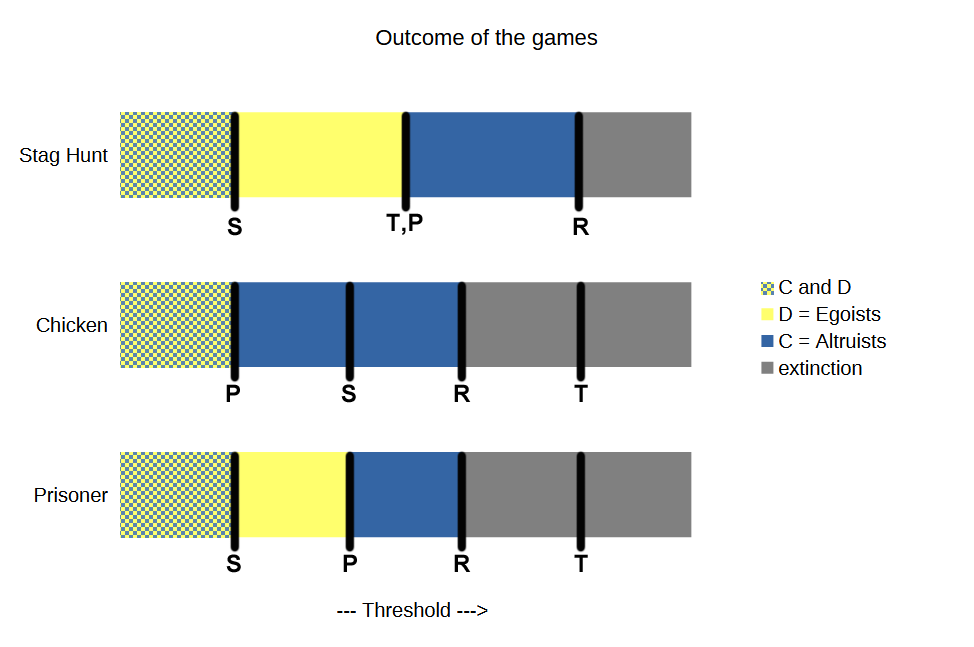Results and Discussion The results are similar to those of the Matrix Games simulation, although the population here is structured across neighborhoods and not in groups.
Here, too, it can be seen that altruistic traits can prevail in both the Prisoner's Dilemma (T > R > P > S) and the Game of Chicken (T > R > S > P) when P < threshold ≤ R. In other words: The threshold must be higher than the payoff for D when it interacts with another D (→ P or punishment), and less than or equal to the payoff for a C against another C (→ R or reward).
In the deer hunting game (R > T ≥ P > S), we achieve a similar result to that of the Matrix Games. So, altruism prevails here at T or P < threshold < R as well. This means that the threshold must be greater than the minimum payoff of D and less than or equal to the payoff for C when competing against another C.

You can find more details about this in the results page of the Matrix Games.
References and further reading
Ackermann, M., Stecher, B., Freed, N.E., Songhet, P., Hardt, W.-D., Doebeli, M., 2008. Self-destructive cooperation mediated by phenotypic noise. Nature 454, 987–990. https://doi.org/10.1038/nature07067
Cremer, J., Melbinger, A., Wienand, K., Henriquez, T., Jung, H., Frey, E., 2019. Cooperation in Microbial Populations: Theory and Experimental Model Systems. Journal of Molecular Biology 431, 4599–4644. https://doi.org/10.1016/j.jmb.2019.09.023
Darwin, C., 1888. The descent of man: and selection in relation to sex. John Murray, Albemarle Street.
Dugatkin, L.A., 2017. The evolution of altruism. Vestn. VOGiS 21, 487–491. https://doi.org/10.18699/VJ17.267
Fletcher, J.A., Doebeli, M., 2009. A simple and general explanation for the evolution of altruism. Proc. R. Soc. B. 276, 13–19. https://doi.org/10.1098/rspb.2008.0829
Fletcher, J.A., Zwick, M., 2004. Strong altruism can evolve in randomly formed groups. Journal of Theoretical Biology 228, 303–313. https://doi.org/10.1016/j.jtbi.2004.01.004
Hamilton, W.D., 1964. The genetical evolution of social behaviour. I. Journal of Theoretical Biology 7, 1–16. https://doi.org/10.1016/0022-5193(64)90038-4
Hardin, G., The Tragedy of the Commons. Science162,1243-1248(1968). DOI:10.1126/science.162.3859.1243
Killingback, T., Bieri, J., Flatt, T., 2006. Evolution in group-structured populations can resolve the tragedy of the commons. Proc. R. Soc. B. 273, 1477–1481. https://doi.org/10.1098/rspb.2006.3476
Kropotkin, P., 1902. Mutual aid: A factor of evolution. McClure Phillips & Co.
Maynard Smith, J., Price, G. The Logic of Animal Conflict. Nature 246, 15–18 (1973). https://doi.org/10.1038/246015a0
Nowak, M.A., 2012. Evolving cooperation. J Theor Biol 299, 1–8. https://doi.org/10.1016/j.jtbi.2012.01.014
Nowak, M. A. & May, R. M., 1992. Evolutionary games and spatial chaos. Nature 359, 826–829. (doi:10.1038/ 359826a0)
Nowak, M. A., Tarnita, C. E., Antal T., 2010. Evolutionary dynamics in structured populations. Phil. Trans. R. Soc. B. 365, 19–30 (doi:10.1098/rstb.2009.0215)
Okasha, S., 2020. Biological Altruism, in: Zalta, E.N. (Ed.), The Stanford Encyclopedia of Philosophy. Metaphysics Research Lab, Stanford University.
Pepper, J.W., 2000. Relatedness in Trait Group Models of Social Evolution. Journal of Theoretical Biology 206, 355–368. https://doi.org/10.1006/jtbi.2000.2132
Price, G.R., 1970. Selection and Covariance. Nature 227, 520–521. https://doi.org/10.1038/227520a0
Sigmund, K., Hauert, C., 2002. Altruism. Current Biology 12, R270–R272. https://doi.org/10.1016/S0960-9822(02)00797-2
Sober, E., Wilson, D.S., 1998. Unto Others: The Evolution and Psychology of Unselfish Behavior, Emersion: Emergent Village Resources for Communities of Faith Series. Harvard University Press.
Steiner, K.F., 2021. The Good, the Bad and the Stochastic: How Living in Groups Innately Supports Cooperation. bioRxiv 2021.02.21.431661; doi: https://doi.org/10.1101/2021.02.21.431661
Steiner, K.F., 2024. Altruism pays off in group-structured populations through probable reciprocity. bioRxiv 2024.01.20.575560. doi: https://doi.org/10.1101/2024.01.20.575560
Trivers, R.L., 1971. The Evolution of Reciprocal Altruism. The Quarterly Review of Biology 46, 35–57. https://doi.org/10.1086/406755
Wilensky, U., 1999. NetLogo. http://ccl.northwestern.edu/netlogo/. Center for Connected Learning and Computer-Based Modeling, Northwestern University. Evanston, IL.
Wilson, D.S., 1975. A theory of group selection. Proc. Natl. Acad. Sci. U.S.A. 72, 143–146. https://doi.org/10.1073/pnas.72.1.143
Wilson, D.S., Wilson, E.O., 2008. Evolution “for the Good of the Group.” American Scientist 96, 380–389.